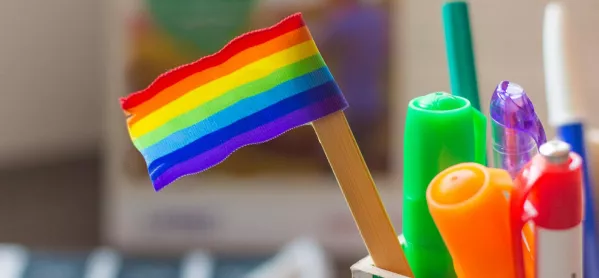A new guide has been published to help teachers in secondary schools adapt their curriculum to make it more inclusive for lesbian, gay, bisexual and transgender pupils, Tes can reveal.
The handbook, produced by the charity Stonewall and sponsored by the education company Pearson, gives practical examples about how teachers across different subjects can tweak their lessons so LGBT students “see themselves represented in what they’re learning”.
Suggestions include setting questions referencing same-sex couples in maths and science, and introducing LGBT-specific vocabulary in language lessons.
LGBT matters in school
In a foreword to the guide, Stonewall’s chief executive Ruth Hunt says that while Britain has made “huge strides” towards LGBT equality in recent years, “anti-LGBT bullying and language unfortunately remain commonplace in Britain’s schools”.
“A crucial part of tackling this problem is delivering a curriculum that includes LGBT people and their experiences,” she adds.
According to a survey by the charity, 43 per cent of LGBT pupils say they don’t feel part of their school community - and two in five report that they are never taught anything about LGBT matters in school and college.
“When LGBT people and their experiences aren’t discussed at school, it gives the impression that LGBT people don’t exist, or that these issues shouldn’t be discussed at school,” the guide states.
The handbook provides “tips, prompts and lesson ideas” which teachers can use to integrate issues throughout the curriculum.
‘Inclusive language examples’
In maths, it suggests including “references to LGBT people and different family structures” when setting questions, such as “Mr X & Mr Y want to know how much it will cost to have a holiday in Italy if...”, or “Lila’s mums are trying to calculate...”.
Teachers are also encouraged to use “inclusive language and examples” when framing questions in science. The guide offers the example of “two women would like to have a baby together, and the doctor recommends they use In Vitro Fertilisation (IVF)”.
In English, the guide suggests introducing students to LGBT authors and themes, as well as including topics in teaching on grammar and language.
When discussing pronouns, teachers can “highlight their importance and what they tell us about a person’s gender, linking to respecting people’s choice of pronouns (including gender-neutral pronouns such as they/them)”.
The guide recommends introducing vocabulary on same-sex couples, gender and LGBT people when covering topics such as family life in modern foreign language classes. In geography, it suggests that teachers can “highlight the experiences of LGBT people in teaching on migration”, including exploring the push and pull factors that might lead LGBT people to migrate internally and internationally.
Sources available
Sharon Hague, senior vice president at Pearson, told Tes: “We know that children will only make the best progress possible if they can feel really comfortable in the environment in which they’re learning and they get to see themselves represented in the classrooms and the materials that they’re studying.”
A former geography teacher, Ms Hague said the guide contained “really nice, practical suggestions to help teachers to really make sure children feel included but to do it in a very natural way”.
She said that Pearson would use the guide to help develop and update its own editorial guidelines in the UK to ensure its resources are LGBT inclusive.
“What we’re doing here in the UK is forming a group to think about how we can do more work around our own policies and guidelines to make sure that all of the teaching and learning resources that we develop are inclusive,” she said.
When asked whether she’d given any thought to how faith schools run by conservative religious denominations might respond to the guide, Ms Hague said: “It will be for the schools to decide what is and isn’t appropriate for their learners. But what we’re trying to do to is to make sure that the resources are available for everyone to choose to use it.”
Want to keep up with the latest education news and opinion? Follow Tes on Twitter and Instagram, and like Tes on Facebook




